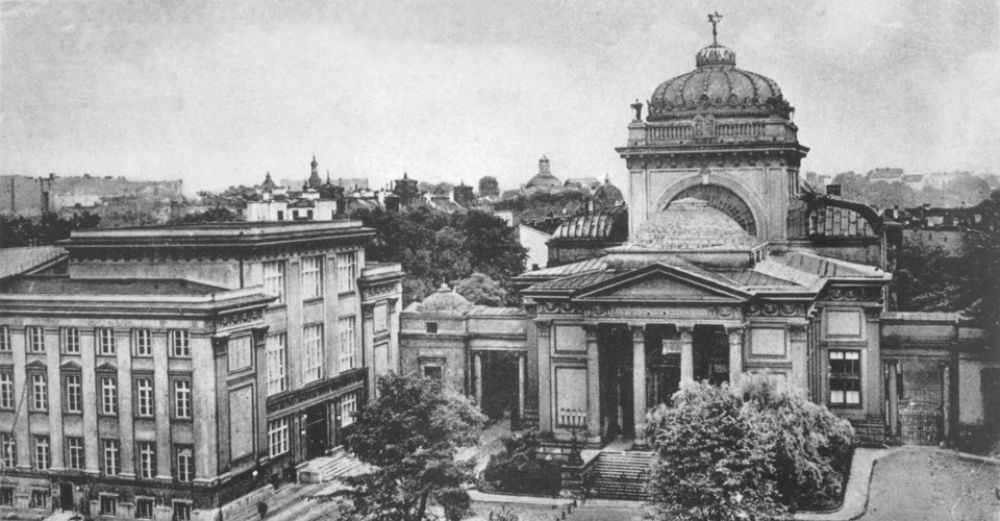- News
- Events
- Oneg Shabbat
- Collections
- Research
- Exhibitions
- Education
- Publishing Department
- Genealogy
- About the Institute
- Bookstore


Exactly 155 years ago, on the 7th of May 1860, during a meeting of the Synagogue’s Committee on Daniłowiczowska Street, dr Ludwik Natanson put forward the motion to establish a library containing books relating to Judaism. The motion was carried; in the early days the library was limited to one room and later grew to over 2500 volumes in two rooms. On the 17th of February 1880 a reading room was opened, accessible twice a week from 5 to 8 p.m. The flood of books and readers led the Committee to start considering a separate building for the library. In 1903 the square to the right of the Synagogue was dedicated to this purpose but further development was halted due to financial and organizational issues and then the start of the First World War. By 1924, when prof Mojżesz Schorr begins a campaign in support of a new building, the library consists of over 30 thousand volumes. Three years later the Committee for the Construction of the Main Judaic Library by the Great Synagogue is established and begins collecting money and announces an architectural design contest for the building which is meant to include storage space for 100 thousand volumes, a reading room, a study room, a lecture hall and a museum hall. Edward Eber wins the contest and construction according to his design begins on the 8th of May 1928.
The opening ceremony of the Main Judaic Library took place on the 22nd of April 1936. Despite many difficulties with funding, the building was very modern: as we can read in the Construction Report the storage space included movable metal shelves, a special vault was constructed of reinforced concrete to hold the most valuable manuscripts, an elevator from “H. Edelman & Co.” was installed, and “the 2nd floor hallway and reading room floors have rubber runners to help maintain a quiet atmosphere”. The building also held the Institute for Judaic Studies.
During the war parts of the library’s collection were looted and others destroyed and the building — which lay within the walls of the ghetto — held the headquarters of the Jewish Self-Aid Organization. The Oneg Shabbat group met here. Later it served as a stage point for Jews deported from Germany and a warehouse for the furniture looted from the ghetto. The building survived the explosion of the Great Synagogue and the Warsaw Uprising, though it was partially damaged; in February 1946 it was turned over the Central Committee of Polish Jews and the Government Building Enterprise “Kraków I” was tasked with its rebuilding. In 1947 the Jewish Historical Institute moved in to no. 3/5 Tłomackie Street and its archives and library collection were once again made available to the public. Currently the JHI’s library has over 80 000 volumes and is the largest collection of books on this topic in Poland. Together with the JHI’s archives they form a priceless collection of documents, volumes and old prints — the oldest manuscript is dated to the 10th century. The biggest treasure and most unique part of the JHI’s collection is of course the Ringelblum Archive, which has been listed on the Memory of the World Register by UNESCO.
2012 is another important date in the history of the Institute and its collection. Thanks to a donation from the Ministry of Culture and National Heritage as part of the Kultura+ priorytet Digitalizacja (Culture — priority digitalization), the support of the Taube Philanthropies and Association of the Jewish Historical Institute and the technological partnership and software prepared by the Research and Academic Computer Network, we could enter the digital age. The Central Judaic Libraryopened in 2014 serves as the gateway. Its purpose is making the entire collection of the JHI available in digital form. This way the JHI’s treasures are available anywhere, at any time and to anyone — researchers, genealogists and anyone interested in the culture and history of Polish Jews. Almost 30 000 documents, books, old prints, manuscripts, newspapers and drawings are currently available in the CJL. Readers can peruse documents from the archival teams of the Jewish Communities in Wrocław and Tarnopol (prior to 1939) and Praga (1939–940) or the Jewish Cultural Society operating after the war. Pre-war and post-war Jewish press is also available, including the most important Yiddish language literary magazine of the inter-war period Literarisze Bleter or Bridges: a Hashomer Hatzair bulletin, published between 1946 and 1949. Most importantly the CBJ makes available the unique library and archive collections: the Ringelblum Archive, 10 000 death certificates from the Warsaw Ghetto, the Jewish population census from Gliwice, the archive of the Jewish Community in Wrocław, as well as manuscripts and old prints in Hebrew, including volumes published in Venice in the 16th century.
Every day, thanks to the work of the Digitalization team, the Collections, Archives and Library Department, new documents, newspapers or books find their way on-line. This way the Central Judaic Library’s collection keeps growing and the dream from 155 years ago that any reader interested in Jewish culture and history can access the books and documents that they might be interested in, is now a reality and can be fulfilled not only in the building in no. 3/5 Tłomackie Street but from any place in the world.